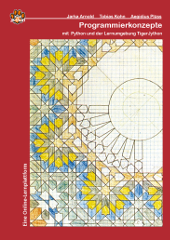Zahlenmuster (Unterprogramme)
Programmieren Sie ein Programm, welches das folgende Zahlenmuster ausgibt: 1, 2, 2, 3, 3, 3, 4, 4, 4, 4, ... Die Zahl x kommt also x Mal vor.
Zusatzaufgabe: Schreiben Sie eine Methode muster(integer), bei welcher der Index (= Position) eingegeben werden kann und dabei die Zahl x berechnet wird. Beispiele: muster(1) -> 1, muster(6) -> 3, muster(7) -> 4. Berechnen Sie damit muster(1'000), muster(10'000) bzw. muster(1'000'000'000). Wer schafft die größten Zahlen, wer die schnellste Berechnung?
Tipp zur Zusatzaufgabe: Führen Sie im ursprünglichen Muster neben der Zahl auch den Index wie folgt mit: (1.:) 1, (2.:) 2, (3.:) 2, (4.:) 3, (5.:) 3, (6.:) 3, (7.:) 4, ...
0 Kommentare
4 Lösung(en)
public class Folge {
public static void main(String[] args) {
Folge folge = new Folge();
for(int i = 1 ; i <= 200; i++) {
System.out.println(i+ ": " + folge.folge(i)); }
System.out.println("time " + System.currentTimeMillis());
System.out.println("10000 " + folge.folge(10000));
System.out.println("time " + System.currentTimeMillis()); }
/** Geschlossene Lösung (s. auch iterative Lösung)
* Liefert das i-te Element in der Folge
* 1, 2, 2, 3, 3, 3, 4, 4, 4, 4, 5, 5, 5, 5, 5,
* Zum beispiel
* f(1) = 1
* f(2) = 2
* f(3) = 2
* f(4) = 3
* f(198) = 20
* f(1000000000) = 44721
*/
int folge(long i) {
i = i - 1;
// Auflösen der Gleichung:
double k = (Math.sqrt(1 + 8*i) + 1) / 2.0;
return (int) k; }
}
// Andere Lösungen: Knuth: The art of Computer Programming Vol. 1
// Kap. 1.2.4 Aufg. 41 (Seite 44 und 479)
Lösung von: Philipp G. Freimann (BBW (Berufsbildungsschule Winterthur) https://www.bbw.ch)
// iterative Lösung (s. auch geschlossene Lösung)
int folge(int sPosition) {
int position = 0, zahl = 0;
while(true) {
zahl = zahl + 1;
position = position + zahl;
if(position >= sPosition) {
return zahl; }
}
}
<?xml version='1.0' encoding='utf-8' ?>
<!DOCTYPE html PUBLIC '-//W3C//DTD XHTML 1.0 Strict//EN'
'http://www.w3.org/TR/xhtml1/DTD/xhtml1-strict.dtd'>
<html xmlns="http://www.w3.org/1999/xhtml" lang="de">
<head>
<title>Folge</title>
<meta http-equiv="Content-Type" content="text/html;charset=utf-8" />
<meta http-equiv="Content-Style-Type" content="text/css" />
<meta http-equiv="Content-Script-Type" content="text/javascript" />
<script type="text/javascript" src= "folge.js"></script>
</head>
<!-- B O D Y -->
<body onload="start();">
<h1>Folge</h1>
</body>
</html>
/* FILE folge.js */
function start() {
var index = window.prompt("Geben Sie den Index ein");
var folgeZahl = folge(index)
window.alert("Die Folgezahl zu " + index + " lautet " + folgeZahl);
}
function folge(index) {
// Auflösen der Gleichung nach x:
// (erster)index = x (x-1) / 2 + 1
//x = (1 + Math.sqrt(8*index - 7)) / 2.0;
// rascher: Knuth:
x = Math.floor(Math.sqrt(2 * index) + 0.5);
return x;
// Andere Lösungen: Knuth: The art of Computer Programming Vol. 1
// Kap. 1.2.4 Aufg. 41 (Seite 44 und 479)
}
// Begründung:
// folge(index) index
// 1 1
// 2 2 3
// 3 4 5 6
// 4 7 8 9 10
// 5 11 12 13 14 15
// ...
// index x = folge(index) x(x-1)/2+1
// = erster index
// mit x = folge(index)
//-------------------------------------------------
// 1 1 1
// 2 2 2
// 3 2 2
// 4 3 4
// 5 3 4
// 6 3 4
// 7 4 7
// 8 4 7
// 9 4 7
// 10 4 7
// 11 5 11
Lösung von: Philipp G. Freimann (BBW (Berufsbildungsschule Winterthur) https://www.bbw.ch)
// C++ 23 | VS-2022
#include <iostream>
#include <string>
#include <vector>
#include <print>
static const auto get_sequence_num(const uint8_t& num_) {
return static_cast<uint64_t>((pow(10, num_) - 1) / 9 * num_);
}
static const auto get_sequence_str(const uint16_t& first_, const uint16_t& last_) {
std::string out{};
for (auto i{ first_ }; i <= last_; ++i) {
for (auto k{ first_ }; k <= i; ++k)
out += std::to_string(i) + " ";
out += "\n";
}
return out;
}
static const auto get_sequence_str(const uint16_t& last_) {
return get_sequence_str(1, last_);
}
static const auto get_number(const uint32_t& index_) {
return floor(sqrt(2 * index_) + 0.5);
}
int main() {
// Aufgabe 1a (Ziffern von 1 bis 9 möglich):
for(auto i{ 1 }; i < 10; ++i)
std::println("{}", get_sequence_num(i));
std::println("");
// Aufgabe 1b:
std::println("{}", get_sequence_str(9));
// Aufgabe 1c:
std::println("{}", get_sequence_str(1, 25));
// Aufgabe 2:
std::vector<uint32_t>v{ 1, 2, 3, 1'000, 10'000, 1'000'000'000 };
for (const auto& e : v)
std::println("{} -> {}", e, get_number(e));
}
Lösung von: Jens Kelm (@JKooP)
Verifikation/Checksumme:
muster(1) = 1
muster(2) = 2
muster(3) = 2
muster(1 000) = 45
muster(10 000) = 141
muster(1 000 000 000) = 44 721
Aktionen
Neue Lösung hinzufügen
Bewertung
Durchschnittliche Bewertung:
Meta
| Zeit: | 1 |
| Schwierigkeit: | k.A. |
| Webcode: | n8f6-73nj |
| Autor: | Philipp G. Freimann (BBW (Berufsbildungsschule Winterthur) https://www.bbw.ch) |




